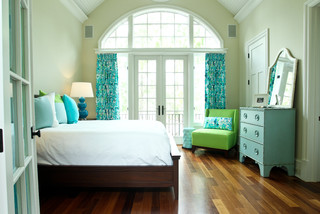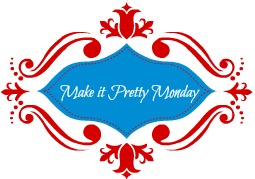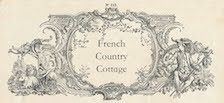I have to come clean and admit that I am in love with the colour turquoise. Look at these incredible photos from Houzz.com:
They demonstrate what a hot design trend turquoise is. I have used AS Provence and combinations of it more than any other colour. Luckily for me, other people are also drawn to the it. My mother-in-law who had lovely traditional taste had turquoise in every living room she owned but it is a colour that was very passé not long ago and one that is decidedly feminine. Because it crosses the blue-green spectrum, it pairs well with a lot of other colours and can be either soothing or energizing. I love it with dark wood; it’s very ’60’s beside strong colours like orange or lime green; it’s very French with grey or antique white; it is bold paired with red and the girl in me loves it with pink and purple.
My friend Katrina who owns Malenka Originals was my first inspiration to use Provence. She had a picture of a mahogany dresser in her shop that she had painted in Provence. It’s gorgeous as you can see.
 The turquoise is distressed to show the red underneath. As soon as I saw it, I knew I would paint a mahogany dresser that was sitting in my basement. I have written about it in a previous post. I also love this chair that I saw at Sophia’s Decor
The turquoise is distressed to show the red underneath. As soon as I saw it, I knew I would paint a mahogany dresser that was sitting in my basement. I have written about it in a previous post. I also love this chair that I saw at Sophia’s Decor 
It’s AS Florence with a white glaze and silver gilding. The white wash tones down the Florence and brings out the turquoise hue. The great detail and the style of chair really suits the way it has been painted.
In the last 2 weeks, I have painted the base of a kitchen table in Provence, a vintage rocking chair in Provence mixed with Florence, a night table in the same mix but with a white wash and 2 older bar stools in the turquoise mix along with Graphite.
Here’s a peak at the rocking chair:
This is the night table. It has Antoinette in the drawer and a pink knob.
The bar stools are about 30 years old. They have rush seats which I painted with the turquoise and Graphite. The pattern in the seats made for an easy diamond effect. I used poly on the seats and the chairs because it is a bit more durable than wax especially on the areas where you would place your feet.
Linking up with:
a href=”http://homecomingmn.blogspot.com/search/label/The%20DIY%27ers” target=”_blank” title=”Running on Happiness”> />
/>
http://www.notjustahousewife.net/
 http://www.funkyjunkinteriors.net/2013/09/party-junk-206-creative-diy-coffee-stations.html
http://www.funkyjunkinteriors.net/2013/09/party-junk-206-creative-diy-coffee-stations.html

Read more at http://diyshowoff.com/2013/09/29/diy-party/#rACJU0eJVBu5ypB8.99





























